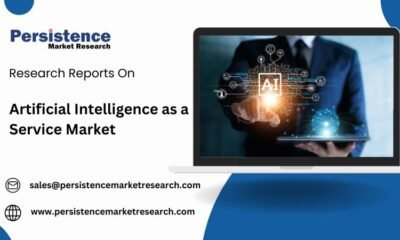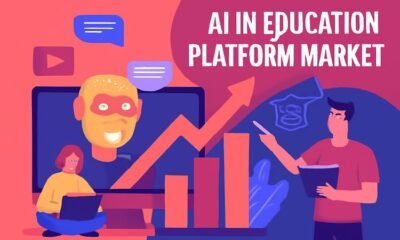AI Insights
Artificial Intelligence (AI) Supercomputer Market Hits New

HTF MI just released the Global Artificial Intelligence (AI) Supercomputer Market Study, a comprehensive analysis of the market that spans more than 143+ pages and describes the product and industry scope as well as the market prognosis and status for 2025-2032. The marketization process is being accelerated by the market study’s segmentation by important regions. The market is currently expanding its reach.
Major Giants in Artificial Intelligence (AI) Supercomputer Market are:
NVIDIA (USA), IBM (USA), Google (USA), Microsoft (USA), Amazon AWS (USA), Huawei (China), Baidu (China), Fujitsu (Japan), Lenovo (China), Cray (USA), Intel (USA), AMD (USA), Graphcore (UK), Cerebras Systems (USA), NEC (Japan)
Request PDF Sample Copy of Report: (Including Full Toc, List of Tables & Figures, Chart) @
👉 https://www.htfmarketinsights.com/sample-report/4367485-artificial-intelligence-ai-supercomputer-market?utm_source=Vaishali_OpenPR&utm_id=Vaishali
HTF Market Intelligence projects that the global Artificial Intelligence (AI) Supercomputer market will expand at a compound annual growth rate (CAGR) of 27% from 2025 to 2032, from 10.5 Billion in 2025 to 40.0 Billion by 2032.
Our Report Covers the Following Important Topics:
By Type:
GPU-based, TPU-based, Neuromorphic, Quantum-enhanced, FPGA-based
By Application:
Scientific Research, Weather Forecasting, Drug Discovery, Autonomous Systems, Financial Modeling
Definition:
AI Supercomputers are high-performance computing systems optimized for AI workloads, such as deep learning training and inference. They feature specialized hardware like GPUs and TPUs designed for massive parallel processing. These systems accelerate AI innovation by handling huge datasets and complex models, enabling breakthroughs in science, medicine, and technology on a global scale.
Dominating Region:
North America
Fastest-Growing Region:
Asia-Pacific
Market Trends:
• Specialized hardware, Quantum computing, Energy efficiency, Edge AI, Cloud integration
Market Drivers:
• AI research demand, Hardware innovation, Cloud computing growth, Big data expansion, Government investments
Market Challenges:
• Costly infrastructure, Power consumption, Complexity, Talent shortage, Scalability
Market Opportunities:
• Scientific breakthroughs, AI democratization, Industry automation, Climate modeling, Personalized medicine
Buy Now Latest Edition of Artificial Intelligence (AI) Supercomputer Market Report 👉 https://www.htfmarketinsights.com/buy-now?format=1&report=4367485
The titled segments and sub-section of the market are illuminated below:
In-depth analysis of Artificial Intelligence (AI) Supercomputer market segments by Types: GPU-based, TPU-based, Neuromorphic, Quantum-enhanced, FPGA-based
Detailed analysis of Career &Education Counselling market segments by Applications: Scientific Research, Weather Forecasting, Drug Discovery, Autonomous Systems, Financial Modeling
Global Artificial Intelligence (AI) Supercomputer Market – Regional Analysis
• North America: United States of America (US), Canada, and Mexico.
• South & Central America: Argentina, Chile, Colombia, and Brazil.
• Middle East & Africa: Kingdom of Saudi Arabia, United Arab Emirates, Turkey, Israel, Egypt, and South Africa.
• Europe: the UK, France, Italy, Germany, Spain, Nordics, BALTIC Countries, Russia, Austria, and the Rest of Europe.
• Asia: India, China, Japan, South Korea, Taiwan, Southeast Asia (Singapore, Thailand, Malaysia, Indonesia, Philippines & Vietnam, etc.) & Rest
• Oceania: Australia & New Zealand
Artificial Intelligence (AI) Supercomputer Market Research Objectives:
– Focuses on the key manufacturers, to define, pronounce and examine the value, sales volume, market share, market competition landscape, SWOT analysis, and development plans in the next few years.
– To share comprehensive information about the key factors influencing the growth of the market (opportunities, drivers, growth potential, industry-specific challenges and risks).
– To analyze the with respect to individual future prospects, growth trends and their involvement to the total market.
– To analyze reasonable developments such as agreements, expansions new product launches, and acquisitions in the market.
– To deliberately profile the key players and systematically examine their growth strategies.
FIVE FORCES & PESTLE ANALYSIS:
Five forces analysis-the threat of new entrants, the threat of substitutes, the threat of competition, and the bargaining power of suppliers and buyers-are carried out to better understand market circumstances.
• Political (Political policy and stability as well as trade, fiscal, and taxation policies)
• Economical (Interest rates, employment or unemployment rates, raw material costs, and foreign exchange rates)
• Social (Changing family demographics, education levels, cultural trends, attitude changes, and changes in lifestyles)
• Technological (Changes in digital or mobile technology, automation, research, and development)
• Legal (Employment legislation, consumer law, health, and safety, international as well as trade regulation and restrictions)
• Environmental (Climate, recycling procedures, carbon footprint, waste disposal, and sustainability)
Get customized report 👉 https://www.htfmarketinsights.com/customize/4367485-artificial-intelligence-ai-supercomputer-market?utm_source=Vaishali_OpenPR&utm_id=Vaishali
Points Covered in Table of Content of Global Artificial Intelligence (AI) Supercomputer Market:
Chapter 01 – Artificial Intelligence (AI) Supercomputer Executive Summary
Chapter 02 – Market Overview
Chapter 03 – Key Success Factors
Chapter 04 – Global Artificial Intelligence (AI) Supercomputer Market – Pricing Analysis
Chapter 05 – Global Artificial Intelligence (AI) Supercomputer Market Background or History
Chapter 06 – Global Artificial Intelligence (AI) Supercomputer Market Segmentation (e.g. Type, Application)
Chapter 07 – Key and Emerging Countries Analysis Worldwide Artificial Intelligence (AI) Supercomputer Market
Chapter 08 – Global Artificial Intelligence (AI) Supercomputer Market Structure & worth Analysis
Chapter 09 – Global Artificial Intelligence (AI) Supercomputer Market Competitive Analysis & Challenges
Chapter 10 – Assumptions and Acronyms
Chapter 11 – Artificial Intelligence (AI) Supercomputer Market Research Method Artificial Intelligence (AI) Supercomputer
Thank you for reading this post. You may also obtain report versions by area, such as North America, LATAM, Europe, Japan, Australia, or Southeast Asia, or by chapter.
Nidhi Bhawsar (PR & Marketing Manager)
HTF Market Intelligence Consulting Private Limited
Phone: +15075562445
sales@htfmarketreport.com
About Author:
HTF Market Intelligence Consulting is uniquely positioned to empower and inspire with research and consulting services to empower businesses with growth strategies, by offering services with extraordinary depth and breadth of thought leadership, research, tools, events, and experience that assist in decision-making.
This release was published on openPR.
AI Insights
OpenAI says spending to rise to $115 billion through 2029: Information

OpenAI Inc. told investors it projects its spending through 2029 may rise to $115 billion, about $80 billion more than previously expected, The Information reported, without providing details on how and when shareholders were informed.
OpenAI is in the process of developing its own data center server chips and facilities to drive the technologies, in an effort to control cloud server rental expenses, according to the report.
The company predicted it could spend more than $8 billion this year, roughly $1.5 billion more than an earlier projection, The Information said.
Another factor influencing the increased need for capital is computing costs, on which the company expects to spend more than $150 billion from 2025 through 2030.
The cost to develop AI models is also higher than previously expected, The Information said.
AI Insights
Microsoft Says Azure Service Affected by Damaged Red Sea Cables

Microsoft Corp. said on Saturday that clients of its Azure cloud platform may experience increased latency after multiple international cables in the Red Sea were cut.
Source link
AI Insights
Geoffrey Hinton says AI will cause massive unemployment and send profits soaring

Pioneering computer scientist Geoffrey Hinton, whose work has earned him a Nobel Prize and the moniker “godfather of AI,” said artificial intelligence will spark a surge in unemployment and profits.
In a wide-ranging interview with the Financial Times, the former Google scientist cleared the air about why he left the tech giant, raised alarms on potential threats from AI, and revealed how he uses the technology. But he also predicted who the winners and losers will be.
“What’s actually going to happen is rich people are going to use AI to replace workers,” Hinton said. “It’s going to create massive unemployment and a huge rise in profits. It will make a few people much richer and most people poorer. That’s not AI’s fault, that is the capitalist system.”
That echos comments he gave to Fortune last month, when he said AI companies are more concerned with short-term profits than the long-term consequences of the technology.
For now, layoffs haven’t spiked, but evidence is mounting that AI is shrinking opportunities, especially at the entry level where recent college graduates start their careers.
A survey from the New York Fed found that companies using AI are much more likely to retrain their employees than fire them, though layoffs are expected to rise in the coming months.
Hinton said earlier that healthcare is the one industry that will be safe from the potential jobs armageddon.
“If you could make doctors five times as efficient, we could all have five times as much health care for the same price,” he explained on the Diary of a CEO YouTube series in June. “There’s almost no limit to how much health care people can absorb—[patients] always want more health care if there’s no cost to it.”
Still, Hinton believes that jobs that perform mundane tasks will be taken over by AI, while sparing some jobs that require a high level of skill.
In his interview with the FT, he also dismissed OpenAI CEO Sam Altman’s idea to pay a universal basic income as AI disrupts the economy and reduce demand for workers, saying it “won’t deal with human dignity” and the value people derive from having jobs.
Hinton has long warned about the dangers of AI without guardrails, estimating a 10% to 20% chance of the technology wiping out humans after the development of superintelligence.
In his view, the dangers of AI fall into two categories: the risk the technology itself poses to the future of humanity, and the consequences of AI being manipulated by people with bad intent.
In his FT interview, he warned AI could help someone build a bioweapon and lamented the Trump administration’s unwillingness to regulate AI more closely, while China is taking the threat more seriously. But he also acknowledged potential upside from AI amid its immense possibilities and uncertainties.
“We don’t know what is going to happen, we have no idea, and people who tell you what is going to happen are just being silly,” Hinton said. “We are at a point in history where something amazing is happening, and it may be amazingly good, and it may be amazingly bad. We can make guesses, but things aren’t going to stay like they are.”
Meanwhile, he told the FT how he uses AI in his own life, saying OpenAI’s ChatGPT is his product of choice. While he mostly uses the chatbot for research, Hinton revealed that a former girlfriend used ChatGPT “to tell me what a rat I was” during their breakup.
“She got the chatbot to explain how awful my behavior was and gave it to me. I didn’t think I had been a rat, so it didn’t make me feel too bad . . . I met somebody I liked more, you know how it goes,” he quipped.
Hinton also explained why he left Google in 2023. While media reports have said he quit so he could speak more freely about the dangers of AI, the 77-year-old Nobel laureate denied that was the reason.
“I left because I was 75, I could no longer program as well as I used to, and there’s a lot of stuff on Netflix I haven’t had a chance to watch,” he said. “I had worked very hard for 55 years, and I felt it was time to retire . . . And I thought, since I am leaving anyway, I could talk about the risks.”
-

 Business1 week ago
Business1 week agoThe Guardian view on Trump and the Fed: independence is no substitute for accountability | Editorial
-
Tools & Platforms4 weeks ago
Building Trust in Military AI Starts with Opening the Black Box – War on the Rocks
-

 Ethics & Policy1 month ago
Ethics & Policy1 month agoSDAIA Supports Saudi Arabia’s Leadership in Shaping Global AI Ethics, Policy, and Research – وكالة الأنباء السعودية
-

 Events & Conferences4 months ago
Events & Conferences4 months agoJourney to 1000 models: Scaling Instagram’s recommendation system
-

 Jobs & Careers2 months ago
Jobs & Careers2 months agoMumbai-based Perplexity Alternative Has 60k+ Users Without Funding
-

 Education2 months ago
Education2 months agoVEX Robotics launches AI-powered classroom robotics system
-

 Podcasts & Talks2 months ago
Podcasts & Talks2 months agoHappy 4th of July! 🎆 Made with Veo 3 in Gemini
-

 Education2 months ago
Education2 months agoMacron says UK and France have duty to tackle illegal migration ‘with humanity, solidarity and firmness’ – UK politics live | Politics
-

 Funding & Business2 months ago
Funding & Business2 months agoKayak and Expedia race to build AI travel agents that turn social posts into itineraries
-

 Podcasts & Talks2 months ago
Podcasts & Talks2 months agoOpenAI 🤝 @teamganassi





















